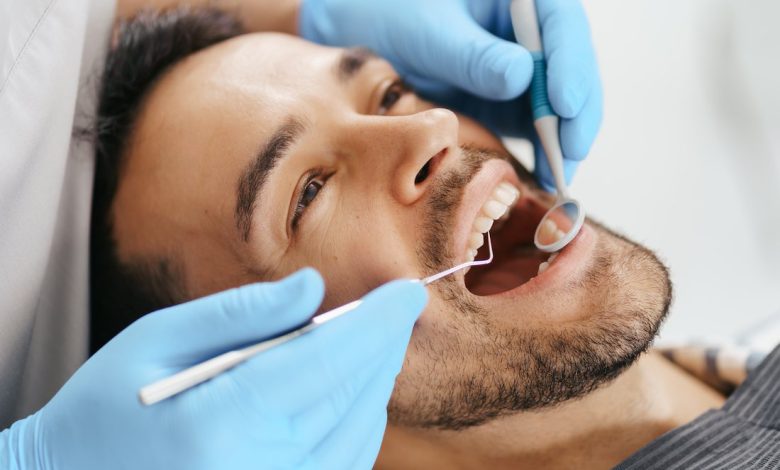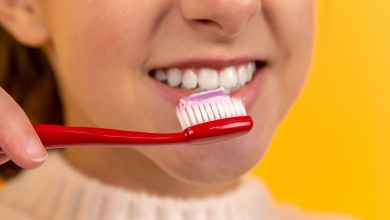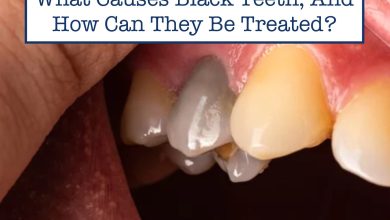Where Does Tooth Decay Start: Uncovering the Hidden Origins

Tooth decay starts when bacteria in your mouth produce acids that attack the enamel, leading to the formation of cavities. If left untreated, tooth decay can cause pain, infection, and even tooth loss.
This common diet-related disease can occur when acid is produced from plaque buildup on your teeth. It is important to recognize the early signs of tooth decay, such as the appearance of white spots where minerals have been lost, in order to stop or reverse the damage.
By understanding the process of tooth decay and taking preventive measures, you can maintain good oral health and avoid the need for extensive dental treatments.
Uncovering The Early Signs Of Tooth Decay
Tooth decay begins when bacteria in your mouth make acids that attack the tooth’s surface (enamel). This can lead to a small hole in a tooth, called a cavity. If tooth decay is not treated, it can cause pain, infection, and even tooth loss. A white spot may appear where minerals have been lost, which is a sign of early decay. At this point, tooth decay can be stopped or reversed. Enamel can repair itself with the help of minerals from saliva and fluoride from toothpaste or water. It’s important to maintain good oral hygiene by brushing twice a day, flossing, and visiting the dentist regularly to prevent tooth decay.
The Tooth Decay Process: From White Spots To Cavities
Tooth decay starts when bacteria in your mouth produce acids that attack the enamel, leading to the formation of small holes called cavities. If left untreated, tooth decay can cause pain, infection, and even tooth loss. It’s important to address early signs of decay, such as white spots, to prevent further damage.
| Tooth Decay |
| Tooth decay begins when bacteria in your mouth make acids that attack the tooth’s surface (enamel). This can lead to a small hole in a tooth, called a cavity. If tooth decay is not treated, it can cause pain, infection, and even tooth loss. |
| Early Decay |
| A white spot may appear where minerals have been lost. This is a sign of early decay. Tooth decay can be stopped or reversed at this point. Enamel can repair… |
| Cavity Formation |
| Cavities are holes, or areas of tooth decay, that form in your teeth surfaces. The causes include plaque buildup and eating lots of sugary snacks… |
The Impact Of Tooth Decay On Dental Health
Tooth decay starts when bacteria in your mouth produce acids that attack the enamel of your teeth. This can lead to the formation of small holes called cavities. If left untreated, tooth decay can cause pain, infection, and even tooth loss.
Recognizing the symptoms of tooth decay is important in order to seek timely dental treatment. Early signs of decay include the appearance of white spots on the teeth, indicating mineral loss. At this stage, tooth decay can still be stopped or reversed through proper dental care.
Cavities don’t always cause pain, so it’s important to pay attention to other symptoms such as sensitivity to hot or cold foods, toothaches, or visible holes in the teeth. If you experience any of these symptoms, it’s recommended to visit a dentist for an evaluation and appropriate treatment.
Preventing tooth decay involves maintaining good oral hygiene by brushing your teeth twice a day, flossing daily, and visiting your dentist regularly for check-ups and cleanings. A well-balanced diet and reducing sugary snacks can also help prevent tooth decay.
Treating Tooth Decay: Prevention And Restoration
| Where Does Tooth Decay Start? |
| Tooth decay begins when bacteria in your mouth make acids that attack the tooth’s surface (enamel). This can lead to a small hole in a tooth, called a cavity. If tooth decay is not treated, it can cause pain, infection, and even tooth loss. |
How to stop or reverse decay during the early stages
A white spot may appear where minerals have been lost. This is a sign of early decay. Tooth decay can be stopped or reversed at this point. Enamel can repair itself by using minerals from saliva, fluoride from toothpaste, and other sources. Maintaining good oral hygiene and regularly visiting a dentist can help prevent and reverse tooth decay in the early stages. Limiting sugary snacks and drinks, brushing twice a day with fluoridated toothpaste, and using dental floss can also aid in preventing decay.
Different treatment options for cavities of varying severity
Cavities are holes or areas of tooth decay that form on the surfaces of your teeth. Treatment options for cavities depend on their severity. For small cavities, a dentist may recommend a filling using materials like composite resin or amalgam. If the decay has spread deeper into the tooth, a dental crown may be necessary to restore its strength and functionality. In cases where the decay has caused an infection or abscess, a root canal procedure may be required. Regular dental check-ups and practicing good oral hygiene habits are essential for early detection and proper treatment of cavities.
Expert Insights: Causes And Prevention Of Tooth Decay
Tooth decay starts when bacteria in your mouth produce acids that attack the enamel, the tooth’s surface. This acid production can lead to the formation of cavities if not treated. Early signs of decay include the appearance of white spots where minerals have been lost. At this stage, tooth decay can be stopped or even reversed. If left untreated, tooth decay can cause pain, infection, and eventual tooth loss.
Preventing tooth decay involves maintaining optimal oral hygiene. This includes brushing your teeth twice a day with fluoride toothpaste, flossing daily, and using mouthwash. Additionally, it’s important to limit your intake of sugary snacks and beverages, as bacteria in your mouth feed on sugar and produce acids that can damage the teeth. Regular dental check-ups and cleanings are also essential for detecting and treating any early signs of decay.
By practicing good oral hygiene and making healthy dietary choices, you can help prevent tooth decay and maintain a healthy smile.

Credit: www.nationalgeographic.com
Dealing With Advanced Tooth Decay: Abscesses And Tooth Loss
| Dealing with Advanced Tooth Decay: Abscesses and Tooth Loss |
|---|
| Understanding the potential consequences of untreated tooth decay |
Tooth decay begins when bacteria in your mouth make acids that attack the tooth’s surface (enamel). This can lead to a small hole in a tooth, called a cavity. If tooth decay is not treated, it can cause pain, infection, and even tooth loss.
A white spot may appear where minerals have been lost. This is a sign of early decay. Tooth decay can be stopped or reversed at this point. Enamel can repair…
Tooth Decay | National Institute of Dental and Craniofacial Research
Cavities (Tooth Decay): Symptoms, Causes & Treatment – Cleveland Clinic
Cavities/tooth decay – Symptoms and causes – Mayo Clinic
Tooth decay is damage that occurs to your teeth, which can potentially result in cavities, dental abscesses, or even tooth loss. It’s caused by…
The Process of Tooth Decay – Pearl Dentistry
Cavities/tooth decay – Symptoms and causes – Mayo Clinic
How do you know if a tooth is starting to decay? Tooth decay | NHS inform
Taking Action: Strategies For Managing And Healing Cavities
Tooth decay begins when bacteria in your mouth produce acids that attack the tooth’s enamel. This can lead to the formation of cavities, which, if left untreated, can cause pain, infection, and tooth loss. It’s important to address tooth decay early on to prevent further damage.
| Where Does Tooth Decay Start |
| Tooth decay begins when bacteria in your mouth make acids that attack the tooth’s surface (enamel). This can lead to a small hole in a tooth, called a cavity. If tooth decay is not treated, it can cause pain, infection, and even tooth loss. |
| Taking Action: Strategies for Managing and Healing Cavities |
| Steps to take if you suspect tooth decay or have been diagnosed with cavities |
| Promoting oral health to prevent further decay and maintain a healthy smile |
Frequently Asked Questions For Where Does Tooth Decay Start
What Part Of The Tooth Decays First?
Tooth decay starts with the attack of bacteria-produced acids on the tooth’s enamel, causing small holes called cavities. If left untreated, it can lead to pain, infection, and tooth loss.
How Do You Know If A Tooth Is Starting To Decay?
Tooth decay begins when bacteria produce acids that attack the tooth’s enamel surface, causing a cavity. This can lead to pain, infection, and tooth loss if left untreated. Early signs include white spots where minerals are lost, but decay can be reversed at this stage.
What Are The 5 Stages Of Tooth Decay?
Tooth decay progresses through five stages. It starts when bacteria in your mouth produce acids that attack the tooth’s enamel, resulting in a cavity. If not treated, decay can cause pain, infection, and tooth loss. The stages include the formation of a white spot indicating early decay, which can be reversed.
How Does Tooth Decay Start?
Tooth decay begins when bacteria in your mouth produce acids that attack the tooth’s surface (enamel). This can lead to the formation of small holes called cavities. If left untreated, tooth decay can cause pain, infection, and even tooth loss.
Conclusion
Tooth decay is a common dental problem that can lead to various complications if left untreated. It all starts when bacteria in your mouth produce acids that attack the enamel, causing a small hole called a cavity. If not addressed, tooth decay can result in pain, infections, and even tooth loss.
Early signs of decay include the appearance of white spots where minerals have been lost. However, tooth decay can be stopped or reversed at this stage. Proper oral hygiene, regular dental check-ups, and a balanced diet are essential for preventing tooth decay and maintaining a healthy smile.




